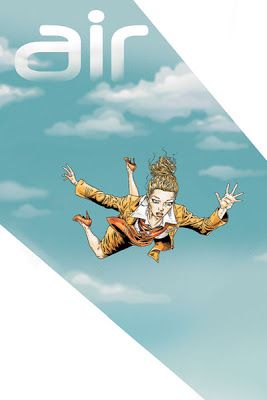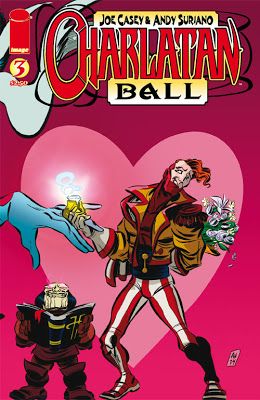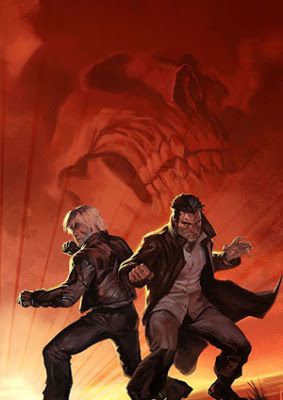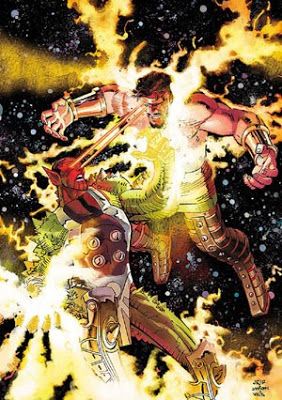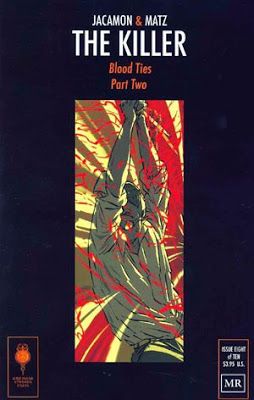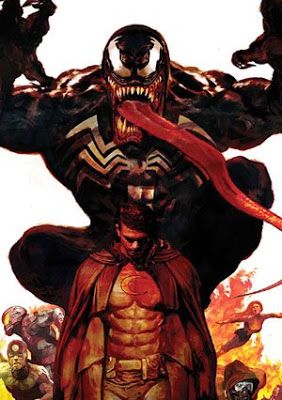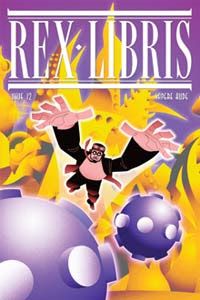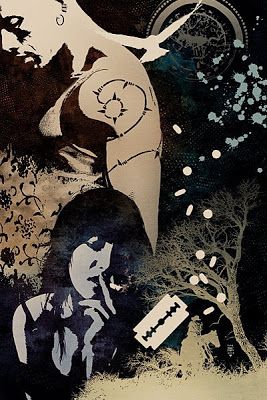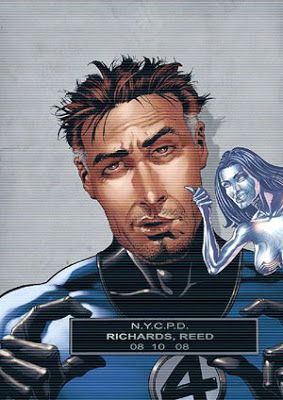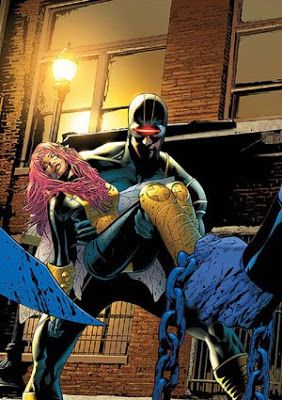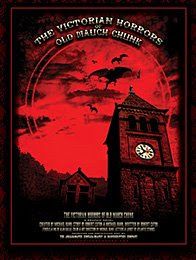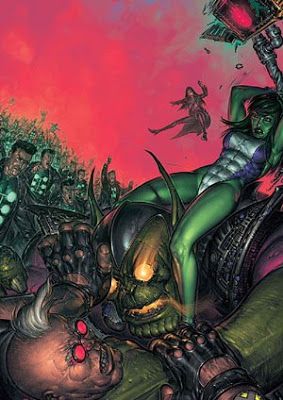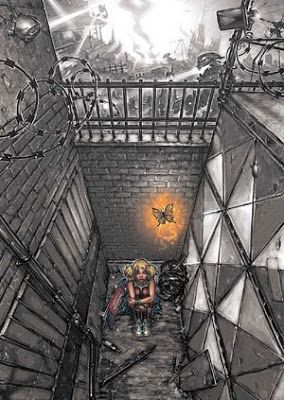It's the third week of the month, which usually means a ton of books for me. And what do you know? It's a ton of books for me! With two books that begin with "Rex," two Jason Aaron books (just like this time last month), two Peter David books, two books with two credited writers, one book about a small town in northeast Pennsyvlania, one unfortunately named associate editor, absolutely no DCU comics (I bought 15 floppies, and only two were DC books, and both were Vertigo), and just how many comics can Joe Caramagna letter anyway? The mind reels! All of this - and more! - below the fold! I doubt you can resist!
Air #1 by G. Willow Wilson (writer), M. K. Perker (artist), Chris Chuckry (colorist), and Jared K. Fletcher (letterer). $2.99, 32 pgs, FC, DC/Vertigo.
The unfortunately named associate editor is the associate editor of this comic. The associate editor is named "Pornsak." Now, I'm sure the associate editor is not American, although I'm not sure. In an American comic book, however, that's an unfortunate name.
Wilson and Perker brought us a darned good graphic novel, Cairo, and now they're off on an ongoing that has a lot of promise but some odd flaws. The hook and its presentation are enough to get me to come back and see where they're going with it, but this didn't blow me away. Still, it's neat.
Wilson tells the story of Blythe, a flight attendant on Clearfleet Airlines who keeps meeting the same man (even though he keeps giving her different names and nationalities) on different flights. She also meets representatives of a group called "The Etesian Front," one of whom tells her that they're dedicated to stopping terrrorists from taking over airplanes. The man Blythe meets, who is called Zayn, is opposed to the Etesian Front, claiming they're not exactly who they say they are. Plus, he tells Blythe there's something fishy going on with her airline, so there's that. Zayn lies repeatedly to Blythe, seduces her, and then is apparently lost in a crash (which is revealed at the beginning of the issue, but is obviously not so, as where would the sexual tension in the book come from if Zayn is dead?). He also, as Brian pointed out, writes her letters from a made-up country, which isn't as dramatic as Wilson wants it to be, because of all the lying he's done previously. And anyway, we only have Blythe's word that it's a made up country, right? If Zayn had sent her a letter from the Hutt River Principality, would she have claimed that was made up, too?
It's an intriguing premise, made a bit more intriguing by the mystical feel that Wilson brings to it. She did the same thing in Cairo, and it was successful in that book, too. I'm a little nervous when vast conspiracies are introduced into entertainment media, but I'm a little less bothered by it when it's not nailed onto something existing (see JFK and 9/11 conspiracies). If Wilson creates this from scratch and doesn't tack on actual historical events, I'll be happier. It can work otherwise, but it's more difficult. Meanwhile, Blythe and Zayn are interesting characters, and as they carry this issue, it's not a problem that the Etesian Front characters are less developed. Blythe is a little too naïve for me (taking a bag from someone you don't know, Blythe? Really?), but we'll see how that goes as the book continues.
There are a few odd problems that I noticed, both with the story and the art. The ending, as Brian noted, isn't as dramatic as it should be, as Zayn has been lying the entire comic, so why would the fact that he puts a made-up return address on a letter be a big deal? Can't you write pretty much anything as a return address? As long as you have proper postage, I don't think anyone cares. Fletcher, Bylthe's flight attendant friend, bugs me too. Perker draws him with somewhat crazy hair, and it bugs me. I don't mean to go all conservative here, but I've never seen a male flight attendant on either national or international flight who are as ungroomed-looking as Fletcher is. This seems to be a problem throughout pop culture - creators often have no idea what professionals look like, because they went straight from waiting tables to living in a celebrity/artistic bubble, where people look however they want to look. I know I'm generalizing (a lot!), but people in offices and in higher-end services don't wear their hair like Fletcher does. The boss would tell him to cut it. Yes, I know I'm being goofy. It's just a minor thing. Plus, Blythe refers to herself as a "stewardess." Do people who work in the industry call themselves that anymore? I don't know. Moving to Perker's art, in one panel, the plane leaves the terminal and it looks freakishly small. Next to it is the tunnel that leads to the plane (at least that's what it looks like), and the plane is toy-like beside it. It's not further back, either, as the plane's tail is in front of the tunnel. Weird. This brings up the problem with the art in general - there's way too much space on the planes. I guess we could argue that all the action takes place in first class, but those are some spacious planes, aren't they? Again, this might be nit-picking (go ahead, say it - I can take it!), but part of the allure of the book is that it takes place in planes, so the planes should be as realistic as possible. That's all.
Man, I'm going on about silly things, aren't I? Okay, I'll just say that this is an intriguing start to the series. And the splash page is pretty darned cool.
Charlatan Ball #3 by Joe Casey (writer), Andy Suriano (artist), Marc Letzmann (colorist), and Rus Wooton (letterer). $2.50, 18 pgs, FC, Image.
As with the first two issues of this series, the third just didn't do it for me. It's fun to read, to a degree, and the odd romance between Chuck Amok and Donnarama is goofy, but it's just lacking coherence (even though I'm sure Casey has a plan for it) and the spark that makes most of Casey's work worthwhile. There's something charming about reading something so out-and-out insane as this, but I find myself wondering what on earth is going on and why I should care. Chuck and Caesar (his rabbit) haven't been developed as characters at all, and although that's not a problem for a while, I keep wondering when it's going to happen. If we don't get a reason to care about these characters soon, the goofiness won't be enough to sustain it. Rex Libris, which also came out this week, is very wacky, too, but Turner has done a great job making Rex an interesting character, so his weird demeanor is intriguing. Chuck's cowardice is just grating. The craziness that swirls around him is fun, but at the core, this comic is falling short.
I'm still not ready to jump ship, though. It's getting close, though. We'll see what next issue brings.
Ghost Rider #26 by Jason Aaron (writer), Tan Eng Huat (artist), José Villarrubia (colorist), and Joe Caramagna (letterer). $2.99, 22 pgs, FC, Marvel.
I miss Roland Boschi, the artist on Aaron's first Ghost Rider arc. Stylistically, I don't have a problem with Tang Eng Huat, and he does a good job on this issue with the bottom-of-the-barrel Marvel characters who show up, plus I like that it appears he's doing that "no inking" thing that Larroca started doing a few years ago on X-Men, which makes his style a bit less harsh. But he doesn't seem like the right fit for what Aaron is doing with Ghost Rider. It's a little too pretty. Boschi had a nice, gritty style that fit with GR being a guerrilla fighter against the rebellious angel Zadkiel, and part of the problem I had with the last prison arc was that Huat's art didn't mesh with the story. This issue, which features goofy Marvel bad guys, is more up his alley, but for the long term, I don't think his art works. Of course, I haven't been paying attention to the upcoming artists, so maybe he's not on the book long. I don't know.
This is a pretty fun issue, as Aaron dredges up some olde-skool Marvel villains and hooks them up with Danny Ketch, and they all go looking for Danny's old mentor. It seems like an issue from the 1990s Ghost Rider, but Aaron does a good job making sure we're not lost. I have read hardly any issues of that series, but I wasn't lost at all. It's not as good as Aaron's first arc, but it's a nice start to the confrontation between Danny and Blaze, which seems to be coming. Plus, there's a nun kicking ass. How can you not love that?
The guy at my comic book store, who likes a lot of interesting comics, scoffed when I bought this. I told him that Jason Aaron is writing it, but that didn't matter to him (even though I'm fairly certain he likes Scalped, although I could be wrong). I don't buy everything that some of my favorite writers write, but I consider them, at least. I mean, I wouldn't go near a Ghost Rider comic if someone I didn't like wasn't writing it, but Aaron is doing a good job with the character. It's odd to ignore a book if a good writer is writing it just because the character has never interested you. Characters aren't good; creative teams are. At least that's what I think. I could be wrong.
The Incredible Hercules #120 by Greg Pak (writer), Fred van Lente (writer), Rafa Sandoval (penciler), Roger Bonet (inker), Greg Adams (inker), Martegod Gracia (colorist), "Calero" (Dennis?) (colorist), "Trevino" (colorist), and Joe Caramagna (letterer). $2.99, 24 pgs, FC, Marvel.
This issue isn't quite as insanely good as the previous few, but it's a good conclusion to the "Sacred Invasion" story arc and leads in nicely to the next arc. There are all kinds of twists and turns in this issue, as Amadeus figures out how he can help Hercules be a great leader and there is, of course, a lot of punching and other violence. What's interesting is how this story blends into the main mini-series, as it appears that what happens here will have important ramifications in the actual Skrull invasion. Unlike the X-Factor/She-Hulk tie-in, which ends ambiguously and might have important ramifications, in this issue we see the effect that Hercules' expedition has on the Skrulls. So that's nice.
It's fascinating looking at the art in this issue. Sandoval's pencils look great, and he does a magnificent job with the violence, especially when the Sun-Eater gets a bad case of indigestion, but the fact that there are two different inkers and three different colorists makes the art a bit uneven. None of the art is bad, but it's interesting to look at the subtle differences between the pages, from thicker lines to slightly different tones. Well, I thought it was interesting.
It appears there are bad things coming for our heroes, perhaps not surprisingly. I'm looking forward to it!
The Killer #8 (of 10) by Matz (writer/translator), Luc Jacamon (artist), Edward Gauvin (translator), and Marshall Dillon (letterer). $3.95, 26 pgs, FC, Archaia Studios Press.
Only two weeks since the last issue! Yay!
We hurtle toward the (presumably) bloody conclusion, and in this issue, Matz does something fascinating - he shows the killer losing his cool, something we haven't seen yet. He gets to carve up the bad guys who beat up his woman, and in two bloody pages (excerpted on the cover there), he slashes them to pieces. We are never unaware of the fact that this man is a killer, but he's such an interesting character and he has been hunted for so long that we forget that he too is a hunter, and this issue shows us that you really don't want to fuck with him. Jacamon does a great job with those pages, too, and with two later double-page spreads where the killer tries to abduct the man who gave the order. This has been, for a while, a meditative and tense comic, and it's neat to see our "hero" go nuts for a change.
It's nice to see Archaia books again. Especially when they come out so frequently!
Moon Knight #21 by Mike Benson (writer), Mark Texeira (artist), Javier Saltares (layouts), Dan Brown (colorist), and Joe Caramagna (letterer). $2.99, 22 pgs, FC, Marvel.
After a quick single issue break, we're back to the slow burn with Moon Knight. I'm going to assume this is another six-issue arc (I haven't looked at the solicitations, so I don't know for sure), and although those kind of things are going out of fashion (if they're not already!), I like the way these arcs are constructed. This story is about the Thunderbolts trying to take down Moon Knight because S.H.I.E.L.D. has failed to do so, but we don't even see Norman Osborn until the final page (he's on the penultimate page, but we see only his hands and mouth). Like the other issues of this comic, there's a lot of set-up, mainly because Benson seems interested in digging into the reality of the Marvel Universe - the pissing contest between Tony Stark and Sikorsky, who sics the Thunderbolts on Spector, takes up four pages and feels like a good example of bureaucratic arguing. We also get to see Marc's associates telling S.H.I.E.L.D. that they would love to give him up, only they don't know where he is. And, of course, there's the requisite machinations of the bad guys and the few pages of Marc in action, shedding the costume and all the trappings of a hero and simply beating some thugs to a pulp. As usual, Benson introduces more moral ambiguity to this comic than we're used to seeing in a mainstream Marvel book when we learn that Carson Knowles - Black Spectre - had Tony Stark tech in his blood. It's just a nice reminder that Tony isn't terribly squeaky-clean. Tony always walking around and taking important meetings with other government officials in his armor is a bit goofy, but that's the way the world works, I guess.
As always with this comic, I lose street cred points whenever I mention how good it is, but damn, it's good. Would I lie to you?
Pistolfist #2 (of 4) by J. S. Earls (writer), David A. Flanery, Jr. (writer), Andres Guinaldo (artist), Jason Embury (colorist), and Ken Nuttall (letterer). $3.99, 22 pgs, FC, Bluewater Productions.
The second issue of Pistolfist worries me. It's still quite good - the art is very nice, and there's some nice pre-Revolutionary intrigue, and a flashback to the Boston Massacre, and the cannon that the British use to destroy an Indian encampment near Fort Ticonderoga is the kind of thing that isn't too weird for this time period even though it's suitably science-fictiony. It ties into the presence of Ben Franklin in the comic, too, which is nice. As far as an entertaining alternative history yarn, the first two issues have been good. I'm looking forward to the last two issues.
Except for the worrisome part, which I have to believe will be more prominent in the next issue. I'm worried about the Native American who rescues our hero. I'm not terribly put off by the fact that a comely Indian lass rescues Salem. What am I worried about is that whenever Indians appear in popular culture these days, it seems like the writers go out of their way to make up for the horrible stereotypes of the past by doing a complete 180 and portraying them as the noblest people ever to walk the earth. This is especially prevalent, it seems, in historical fiction (which is partly why it doesn't seem to affect Scalped and why that's such a damned fine comic). I don't have a problem with portraying Natives as noble, but the deification of Indian culture over the past 20-30 years is kind of annoying. I really hope Earls hasn't succumbed to it. Dyani can be a noble character, but it has to be because of something within her, not because she's a Native American. So I'm worried. We'll see if I have any reason to be worried next issue. I will, of course, be buying it, because Pistolfist is entertaining. And isn't that why we're here?
Rex Libris #12 by James Turner (writer/artist). $3.50, 33 pgs, BW, SLG.
It's the penultimate issue of one of the most wonderful comics out there, and as usual, it's a blast. For those people who were upset about Rex's speech patterns (and I understand that, even though I tend to ignore the issue), we get an explanation! You might not like the explanation, but at least you get one! There's the usual insanity, as Rex, Circe, Hypatia, the government, and all the bad guys (including super-Yeti) converge on Ryleh II, the island under which Cthulhu Two is slumbering, all of them intent on either stopping him from waking or using him for their own nefarious ends. So of course there's all sorts of kookiness and weird creatures, including:
- The aforementioned super-Yeti;
- Imperial war penguins (with corrosive projectile vomit);
- The Kraken;
- The Skylords of Bel;
- Reptiliod shockthugs;
- Iagite cultists;
- The Tenebrati - a cabal dedicated to an ideology of darkness;
- Edulean space cockles;
- Rogue saturnite floaters;
- The Blue Claw Crime Cartel;
- Asteroidean starfish cruisers;
- Balloobots;
- Ninjas. Because who doesn't love ninjas?
God, I'm going to miss this book. Oh well.
Rex Mundi #13 by Arvid Nelson (writer/letterer), Guy Davis (artist, "Ishmael"), Dave Stewart (colorist, "Ishmael"), Brian Churilla (artist, "Hill of Martyrs"), and Jason Millet (colorist, "Hill of Martyrs"). $2.99, 22 pgs, FC, Dark Horse.
This is, as you know, one of my absolutely favorite comics, but that doesn't mean I love every issue. This is a good example of that. Nelson takes a break from the main story, which is fine, but although the two stories he gives us in the interim are decent, they don't really have the verve of the main story. The Guy Davis story (which features a man with a penis as a nose, which shows why comics are awesome, as this is not the first man in comic book history with a penis as a nose) is quick and fairly obvious, but it features Guy Davis art, and that's always a treat. The second story, which features Churilla's nice, clean, slightly old-school-Stuart Immonen style, is a Brother Matthew murder mystery. Brother Matthew is a character featured in a webcomic years ago who was apparently quite popular. The murder mystery he's tasked to solve sounds interesting, but then ... the comic ends, and we are instructed to follow the mystery online. Now, you can follow the mystery at the Mothership, so I shouldn't say anything bad about it, but this really chaps my hide. I hate reading stuff online. Okay, I like reading blogs and stuff, but I don't like appointment reading, because too often I forget about it. I can always catch up later, when the mystery is finished (it will be done in October), but still, I'm grumpy. I shouldn't bitch too much, because it's always nice to see murder mysteries in comics, especially if they're done well, but I'm bitching anyway. That's what being an American is all about!
So it's not my favorite issue, but that's okay. It's still a great comic book.
Scalped #20 by Jason Aaron (writer), Davide Furnò (artist), Giulia Brusco (colorist), and Steve Wands (letterer). $2.99, 22 pgs, FC, DC/Vertigo.
I skipped this again, because I'm still waiting for the third trade to come out, but just like last issue, it appears there's a lot of nudity in this issue. That's always good to see.
True Believers #2 (of 5) by Cary Bates (writer), Paul Gulacy (artist), Rain Beredo (colorist), and Dave Lanphear (letterer). $2.99, 22 pgs, FC, Marvel.
Well, of course there are extenuating circumstances behind Reed Richards' DUI! He's a hero, after all, and while heroes can occasionally go bad and kill hundreds if not thousands of people but can be forgiven for that, there's no forgiving a DUI in the Marvel Universe! That would imply that we should forgive DUIs in the United States! We can't have that! (I also like that if you get pulled over for driving under the influence in the Marvel Universe, you automatically have disheveled hair and a scruffy chin. As if the only way you can ever get pulled over for drunk driving in the world is if you just crawled out of a gutter after a three-day bender. Maybe Reed had two appletinis while out on a date with Sue - that would probably be enough to push him over the legal limit!)
Okay, so I'm a bit disappointed this wasn't about Reed driving drunk, but that's okay. It turns into a story about how desperate some people are to be celebrities, which in the Marvel U. means superheroes. We also learn more about Payback, the leader of the True Believers, as she visits a psychiatrist and talks about her father. This will presumably be a major part of the rest of the series.
This is a nifty little series, as Bates is doing a nice job so far with the less-than-heroic corners of the Marvel U. And more superheroes should probably talk to psychiatrists, so it's cool to see one actually doing so. And there's a weird cliffhanger to end it, so that's keen.
Uncanny X-Men #501 by Matt Fraction (writer), Ed Brubaker (writer), Greg Land (penciler), Jay Leisten (inker), Justin Ponsor (colorist), and Joe Caramagna (letterer). $2.99, 22 pgs, FC, Marvel.
I don't have any idea if that "queer" thing was supposed to be in the script or not, but it's fairly obvious that mutant-beating the Marvel U. is analogous to gay-bashing in the real world. Who cares, though? Every once in a while, a mutant has to get beaten up in an X-Men comic. It's tradition!
I have to break down how much I dislike this issue of Uncanny X-Men. It will pain me to do so, because Brubaker, prior to issue #500, was getting a better handle on the book, and Fraction is one of the best new writers in comics right now. I wanted to ignore the Land art, but I can't. Plus, the story is awful.
Let's start with the beating. On page 2, Megan gets hit by the bat-wielding punk. Land's "drawing" of Megan bears absolutely no relation to the rest of the scene and looks nothing like someone getting hit in the back with a bat. That's just the start. For all those people whose eyes would burn out of their heads if Northstar ever even held hands with another man, I hope they're pissed off about the first scene with Emma and Scott. Two unmarried people screwing just for fun? Shocking! Even though Emma brings up the fact that the X-Men are all horny since moving to San Francisco, that doesn't make it right! The porno stylings of Land's art gives me the creeps, and their conversation about making babies doesn't "sound" right. This is often a problem with superhero books, especially ones with ancillary books in which important stuff happens (the whole baby thing that Cable is dealing with). Frubaker is trying to write "meaningful" dialogue between the two, but it kind of comes out of nowhere and doesn't feel as heartfelt and even tragic (in Emma's case) as it's meant to be. And the fact that Scott can't tell Emma what he's doing with the crib speaks volumes about how real their relationship is. Maybe that's what Bruction is going for. Beats me.
Then we switch to Scott and Warren driving across the Golden Gate Bridge. The only reason we know it's Scott is because of the glasses, as he looks different from the scene before. Ah, the joy of tracing. I have always liked the idea of the X-Men being more open about who they are, so the "sanctuary" is a good idea. Megan shows up and everyone gets angry, and we switch to the bad guys behind the attack. Oh, it's angry punks. Well, that's dandy. And then the X-Men lay an ambush for them. So there's that.
The plot is simple, sure, but it just doesn't feel like Frubaker is trying that hard. The clever introductions to each character grate instantly (Warren Worthington: "skajillionaire"; Hank McCoy: "beast-like. Beauty, too"). The dialogue is also trying far too hard to be clever, and it's simply annoying. I can deal with the horrible art if the story was better, but this is just bad. I actually like the ideas that Bruction is toying with, but the execution, at least for the past two issues, has been subpar. As usual with writers I admire, I'll give this more rope than I might something else, but it's on the block. Too bad.
The Victorian Horrors of Old Mauch Chunk #1 by Robert Caton (story/writer), Michael Bann (story), and Allan Gallo (artist). $3.95, 24 pgs, BW, The Amalgamated Simulca-graphy & Manuscription Co.
Ah, beautiful Jim Thorpe, Pennsylvania. Who would have guessed you could set a comic book there? Did you know that Jim Thorpe has absolutely no connection with the famous Native American athlete? After he died, the town of Mauch Chunk, looking to attract tourism, bought his remains from his third wife, changed the name of the town, and erected a monument to him. Thorpe did play college football in Pennsylvania, but at Carlisle, which is not close to Mauch Chunk. It's a strange little footnote in history. The town itself is rather nice. Make a side trip there if you're headed from New York to Philadelphia!
Oh, the comic? Yeah, I suppose I should get to that. Story-wise, it's a fairly standard horror tale, and it does it well. If you like horror, it's definitely something to check out. Up in Mauch Chunk, miners discover a huge cave that is apparently not natural. They're watched by ... well, something. In Philadelphia, a Villanova professor named James Ashton is tasked to investigate, and he learns that a crystal from the cave has some interesting properties. On the way there, his train is stopped when the tracks ahead are destroyed. When he reaches the town, he sees someone he knows, someone he's stunned to see. A crazy man (I think it's a man) warns him away from the town and asks to meet him later that night to show him documents that will prove how horrible things are. Of course, the man is killed by something, and Ashton never gets to learn the secrets of Mauch Chunk. Oh dear.
It's a gripping story, if a bit familiar, but where the book shines is the art. The comic is in sepia tones (just like the world was back then) and it looks fantastic. Gallo has a great sense of the time period and the design of the book. It's intricately drawn, and every character is established very well with distinct personalities. It's a gorgeous comic, and the only color - red - is used sparingly and very effectively. The story is decent, but the art makes the book shine.
The creators effectively add advertisements for actual Jim Thorpe businesses, giving the book a true olde-tyme pulp magazine feel. I never like adverts, but the way they're integrated into this book makes it less egregious.
This book is four dollars, but it's worth a look. Seek it out!
X-Factor #34 by Peter David (writer), Larry Stroman (penciler), Jon Sibal (inker), Jeromy Cox (colorist), and Cory Petit (letterer). $2.99, 22 pgs, FC, Marvel.
You know, a "Secret Invasion" tie-in and a She-Hulk crossover is probably not the best way to put a story together, and although David does the best job he can, this has been a kind of pointless three-issue arc. She-Hulk and X-Factor beat on each other for a while, Darwin saves the day, Jen and Jazinda cart the bad Skrull away, and everything ends with a bit of a whimper. Jen doesn't even know what she's going to do with bad guy Skrull, because everyone suddenly realizes that Tony Stark might actually be an alien. Imagine that.
Because it's David, it's entertaining, as he comes up with a nice way for the good guys to win, throws in some decent dialogue, and keeps things humming along. At least this arc didn't drag, which is appreciated. And Stroman's art is good, unless you don't like Stroman's art. But that would be mean.
X-Factor Special: Layla Miller by Peter David (writer), Valentine de Landro (penciler), Andrew Hennessy (inker/finisher), Craig Yeung (inker), Jeromy Cox (colorist), and Cory Petit (letterer). $3.99, 32 pgs, FC, Marvel.
The second X-Factor book this week is the special that drops in on Layla Miller, who's still stuck in the future. As I did when the first special, which focused on Quicksilver, came out, I'd like to go a bit olde-skool on you. Remember when these ancillary stories were simply single issues of the main comic? I'm thinking of those issues of Uncanny X-Men where Claremont ignored the main storyline and focused on a character. We had to wait months before the main arc picked up again, but we didn't care (well, I didn't have to wait, as I bought these comics as back issues, but you get my meaning). Both the Quicksilver story and this one are longer and cost more than a regular issue of X-Factor, but there's no real reason why they couldn't have been part of the regular series. The Quicksilver story could have been shorter to fit into the 22-page format, as it felt a bit padded. This story probably couldn't have been cut too much, so maybe David could have expanded it a bit to make two issues, or it could have been a "giant-sized" issue of the regular series. I don't really care all that much, but it's just strange that companies do this. I'm sure it has nothing to do with getting extra money out of us. Damn.
Anyway, this is an interesting story about Layla as she escapes from prison and tries to spark a revolution. It's clever because of the presence of Layla, who's always fun. She knows all the angles, and it's cute watching her maneuver through the world in which she's trapped. Of course, we get the awkward attempts to explain why Cyclops is still alive 80 years in the future and why his daughter is still young and hot, but that's what we deal with in comic books.
It's a nice addition to the X-Factor canon, even though Layla doesn't get to come back to the present. The quicker she does, the better it will be. But that's just me - I don't really like stories set in the future. That's a personal pet peeve, however. You might like them.
Well, that's a grip of comics. (I'm down with the hip lingo, don't you know.) Have fun explaining why I really should have bought some DC comics and why I'm so very wrong about Moon Knight. I won't listen, but it will make you feel better, I'm sure!
And, just for fun, here's some totally random lyrics:
"It's a broken kind of feeling, she'd have to tie me to the ceiling
A bad moon's a comin' better say your prayers, child
I wanna tell you that I love you, but does it really matter?
I just can't stand to see you dragging down again
Again, my friend again, oh yeah"
One of my favorite songs from one of my favorite albums. But what could it be?


